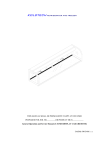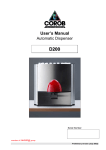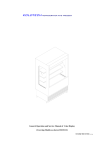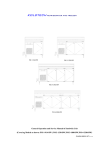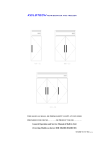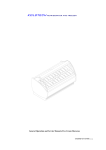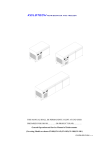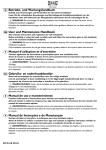Download Whirlpool AKR 769 GY
Transcript
INSTRUCTIONS FOR USE BEFORE USING THE HOOD SAFEGUARDING THE ENVIRONMENT IMPORTANT INSTRUCTIONS FOR SAFETY USING THE HOOD CARE AND MAINTENANCE TROUBLESHOOTING GUIDE AFTER-SALES SERVICE INSTALLATION 43 BEFORE USING THE HOOD • • • • Please read these instructions carefully and keep them for future reference, in order to ensure best use of your hood. This appliance is designed to be used only by adults. The appliance is not intended for use by children or infirm persons without supervision. Make sure children do not play with the appliance. Do not connect the appliance to the mains power supply until installation has been completed. • • • • WARNING: Check whether the exhaust pipe and clamps are provided. If not, they must be purchased separately. Packaging materials (plastic bags, polystyrene, etc.) can be dangerous for children and should be kept well out of their reach. Make sure the hood has not been damaged during transport. Installation and connection to the mains and exhaust ducts must be carried out by a qualified technician, in accordance with the manufacturer's instructions and local safety regulations. SAFEGUARDING THE ENVIRONMENT 1. Packaging Packing materials are 100% recyclable and are marked with the recycling symbol . Comply with local regulations for their disposal. Packaging materials (plastic bags, polystyrene, etc.) can be dangerous for children and should be kept well out of their reach. The symbol on the appliance or accompanying documentation indicates that this product should not be disposed of as unsorted municipal waste but must be taken to a collection point for the treatment of WEEE. Disposal must be carried out in accordance with local environmental regulations for waste disposal. For further information on the treatment, recovery and recycling of this appliance, contact your competent local authority, the collection service for household waste or the shop where you purchased the appliance. 2. Product This appliance is marked in compliance with European Directive 2002/96/EC on Waste Electrical and Electronic Equipment (WEEE). By ensuring that this appliance is scrapped suitably, you can help prevent potentially damaging consequences for the environment and health. IMPORTANT INSTRUCTIONS FOR SAFETY WARNING: To reduce the risk of accidents, electric shock, injury or damage, when using the hood comply with the basic precautions, including the following. 1. Always disconnect the hood from the power supply before carrying out any installation or maintenance operation on the appliance. 2. Installation must be carried out by a specialised technician, in compliance with the manufacturer’s instructions and local safety regulations. 3. Earthing of the appliance is compulsory. (Not possible for Class II hoods). 4. Never use multisockets and extension leads. 5. The electrical components must no longer be accessible to the user after installation. 6. Do not touch the hood with wet parts of the body or use it when barefoot. 7. Do not pull the appliance power cable to unplug it. 8. After-sales service – do not repair or replace any part of the hood unless specifically indicated in the manual. All other maintenance services must be carried out by a specialised technician. 9. When drilling the wall, make sure not to damage the electrical connections and/or pipes. 10. The ventilation ducts must always discharge to the outside. 11. The Manufacturer declines any liability for improper use or incorrect setting of the controls. 12. The appliance is not intended for use by children or persons with limited physical, sensory or mental abilities or without experience and knowledge of it, unless they are under the supervision of or instructed in its use by a person responsible for their safety. 13. Keep children away. 14. To reduce the risk of fire, only use a metal inlet duct. 15. Children must be supervised so that they do not play with the appliance. 16. The product must be disposed of in compliance with local regulations on waste disposal. 17. For further information on the treatment, recovery and recycling of this product, contact the competent local office, the household waste collection service or the shop where you purchased the appliance. 44 24. Make sure the lamps are cold before touching them. 25. The hood is not a shelf, therefore do not overload or place objects on it. 26. Do not use or leave the hood without its lamps correctly installed - risk of electric shock. 27. Wear work gloves for all installation and maintenance operations. 28. The product is not suitable for outdoor use. 29. The air sucked by the hood must not be eliminated through the same flue of the heating system or other appliances using gas or other fuels. 18. Regular cleaning and maintenance is essential for correct hood operation and good performance. Frequently clean all encrustations from dirty surfaces to prevent the accumulation of grease. Regularly clean or replace filters. 19. Do not “flambé” food under the hood. Naked flames could cause a fire. 20. The room must have adequate ventilation when the hood is used at the same time as appliances operating on gas or other fuels. 21. The discharge air must not be eliminated in a duct used to remove fumes produced by appliances operating on gas or other fuels, but must have a separate outlet. All the national regulations on air discharge envisaged by art. 7.12.1 of CEI EN 603352-31 must be observed. 22. If the hood is used together with other appliances operating on gas or other fuels, the negative Note: always wear work gloves for all installation and maintenance operations. Declaration of conformity This product has been designed, manufactured and sold in compliance with the following standards: - safety objectives of the “Low Voltage” Directive 2006/95/EC (which replaces 73/23/EEC as amended) - protection requirements of “EMC” Directive 89/336/EEC amended by Directive 93/68/EEC. pressure in the room must not exceed 4 Pa (4 x 10-5 bar). Therefore, make sure the room is adequately ventilated. 23. Do not leave pans unattended when frying, since the cooking oil could catch fire. USING THE HOOD Switch on the hood a few minutes before starting to cook and leave it running for at least 5 minutes after you have finished. 1. Pull out the steam drawer (depending on model). This improves hood performance. 2. Turn the speed selector to the required speed setting according to the quantity of fumes and steam to be extracted. 3. Switch off the hood 5 minutes after you have finished cooking. 4. Close the steam-collecting drawer (where fitted). 45 CARE AND MAINTENANCE Always disconnect the hood before cleaning or carrying out maintenance by unplugging it or switching off the power supply. Grease filter The sponge grease filter should be washed in hot soapy water once a month (soak for 1-2 hours, do not wring, leave to dry and then remount. If necessary, repeat the process. Replace with a new filter every 5-6 washes). • The grease filter paper should be replaced at least once a month. • Grease filter paper with saturation indicator should be replaced at least every two months or whenever the colour becomes visible through the holes of the grille. The paper filter is coloured on one side. This colour should not be visible through the grille holes when the filter is installed. • Metal grease filters should be washed once a month either by hand or in a dishwasher at a low temperature and in a short cycle. Leave filter to dry before remounting it. Washing in a dishwasher can cause grease filters to turn white, but this in no way affects efficiency. Whenever cleaning or replacing the grease filters, clean all other exposed parts of the hood. • Carbon filter (“Air recirculation mode”, see following page) The carbon filter cannot be washed or regenerated. In some cases, carbon filters can be washed, but only when specified in the attached Product Description Sheet. Replace the carbon filter (normal usage) every 6 months (Rectangular carbon filter) every 4 months (Circular carbon filter). Replacing bulbs 1. Pull out the steam deflector (depending on model). 2. Open the grille or light fixture and remove the grease filter. 3. Remove the burnt-out bulb and replace it with a new one of the same wattage. Close the grille, light fixture or metal grease filter. Cleaning the hood Use a soft cloth with methylated spirits or a mild liquid detergent. Never use abrasive substances. never clean the appliance with high pressure water or steam cleaning equipment. WARNING: Failure to remove oil/grease (at least once a month) could result in fire. Important: Failure to observe the instructions for cleaning the appliance and replacing or washing the filters may cause a fire. TROUBLESHOOTING GUIDE The hood does not work: • • • The light does not work: • Does the bulb need replacing? • Is the bulb correctly fitted? • Is the fuse blown? Never try to carry out any repair by yourself other than fixing the above-mentioned problems. Is the plug properly inserted in the power socket? Is there a power failure? Is the fuse blown? Insufficient suction power: • • • Is the right speed selected? Do the filters need cleaning or replacing? Are the air outlets blocked? 46 AFTER-SALES SERVICE Before calling the After-sales Service • The exact model of the appliance, • your full address, • your telephone number and area code. The service code (number below the word SERVICE on the rating plate inside the hood behind the grease filter). 1. Check to see if you can fix the problem yourself (see “Troubleshooting Guide”). 2. Switch the hood off and then on again to check if the problem has gone. 3. If the problem persists, contact the After-sales Service. Specify: • the nature of the problem, INSTALLATION When installing the hood, the minimum distances from the cooktop must be respected, and the numerical sequence and additional instructions must be followed exactly as indicated on the Installation sheet. Extractor Version ( - see also instruction sheet) A Cooking fumes and vapours are conveyed outside through a duct connected to the hood by means of a collar. The outlet duct diameter must be the same as that of the collar. If a flue-damper is to be installed, check that it can open and close freely when installation of the exhaust duct is complete. The hood can be supplied with one (upper) or two (upper and rear) exhaust outlet holes. The hood is usually set up for using the upper exhaust outlet. 1. The collar must be seated in the upper exhaust outlet. Use the rear exhaust outlet (where present). 1. Where fitted, remove the cover closing off the rear outlet and collar. 2. Some models are fitted with a plastic deflector that closes off the rear outlet. If fitted, remove it. 3. Fit the collar in the rear outlet. 4. Put the cover (if fitted) in the upper outlet. Important: If the hood has a carbon filter, this should be removed. Check that the switch inside the hood (if fitted) is on position “A” Extractor; if not, set it to this position. Filter Hood ( - see also installation sheet) F The air is filtered by a carbon filter and recycled into the surrounding atmosphere. The filtered air is released towards the kitchen ceiling. Important: If the hood does not have a carbon filter, order one and fit it before use. Check that the switch inside the hood (if fitted) is on position “F” Filter; if not, set it to this position. If the plug is provided, close off the upper exhaust hole. Electrical connections Before connecting the hood, make sure the voltage indicated on the rating plate corresponds to the voltage in your home. The plate is located inside the hood behind the grille. If the hood is fitted with a standard plug, insert it into a matching standard socket in an easily accessible location. If the hood is not fitted with a plug, fit one that conforms to applicable standards or use a double-pole switch that conforms to applicable standards with a minimum contact separation of 3mm, in an easily accessible location. The Manufacturer shall not be liable for any damage or problem arising from the failure to comply with the above-mentioned instructions. WARNING! Before reconnecting the hood circuit to the mains power supply and checking correct operation, make sure the power cable is correctly fitted and that it was NOT crushed in the housing during installation. Make sure to have this operation carried out by a specialised technician. 47 48






